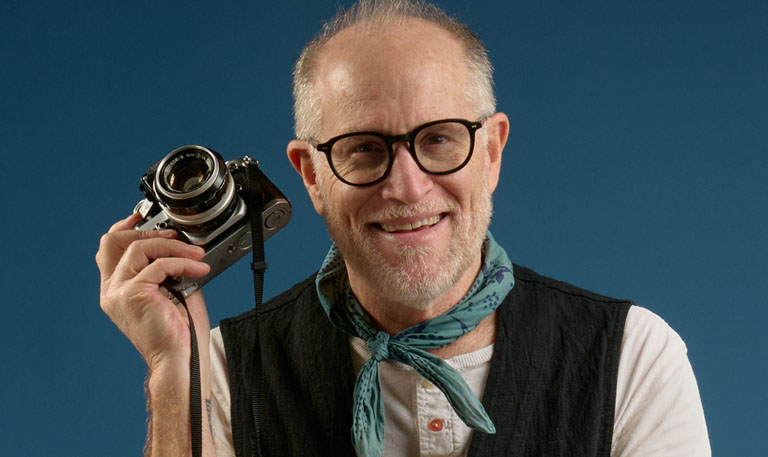When I got home after interviewing photographer Ernie Sapiro, the first thing I did was pull my high school yearbook from the shelf. He and I had just discovered that we were both in the same (huge) class at Seattle’s Roosevelt High School, though we hadn’t known each other back in 1974. There he was, shoulder-length shag haircut, big grin, bow tie. Or was it him? The yearbook caption read, “Douglas I. Sapiro. Track. Skiing.”
“Yes, my real name is Douglas Irving,” Ernie said via email. “It’s pretty ridiculous but here goes. When I was young, I had strawberry blonde hair and freckles. Down the block there was another kid, a couple years older than me who also had red hair and freckles. His name was Ernie. For whatever reason they started calling me Ernie Two and it just stuck at the time.” Douglas/Ernie decided he liked it. “My family calls me Douglas, but the rest of the world calls me Ernie.”
Douglas, a fine name, to be sure. But I have to say it doesn’t fit Ernie Sapiro nearly as well as Ernie.
As a photographer, Sapiro has a knack for putting people at ease. He’s not opposed to artsy techniques, but his focus is on capturing his subject’s soul. Sapiro has photographed several 3rd Act Magazine covers and in them you can see that when he says “soul,” he’s talking about the exuberant, joyful core of a person. Nothing dark and stormy here. The cover of singer/songwriter/musician LeRoy Bell is one of his favorites. I happen to love the one of track star Madonna Hanna.
Photography has not been his lifelong calling. It is Ernie Sapiro’s own third act. He began his adult life as a guitar player in a number of iconic Northwest rock bands, including Uncle Cookie, the Moberlys, The Lonesome City Kings, and the Cowboys. His day job, for 30 years, was with Red Robin, the beloved Seattle burger restaurant that grew into a national chain. “I started as a janitor and left as a vice president,” Sapiro said. When he left, “about a dozen years ago,” there were 450 Red Robins across the country. Many of them had been opened by Sapiro himself. After Red Robin, he worked for Restaurants Unlimited for a few years. And then he was done and ready for his third act.
Sapiro’s father, Scotty Sapiro, was a photographer—first in New York and then in Seattle. The family moved across the country when Ernie was nine. Scotty Sapiro’s clients eventually included Rainier Beer, Nordstrom and Eddie Bauer. Ernie loved hanging out in his dad’s studio, even though he did not ever imagine, until he retired from the restaurant world, that he would someday follow in Scotty Sapiro’s footsteps.
But he remembers his father’s best bit of advice: When you’re looking through the viewfinder, “Look for something that you haven’t seen.” Ernie’s expanded version: “It’s like jazz. You start in one place and wind up somewhere else.”
But, as with jazz, you have to know what you’re doing. You have to practice. And study. All of which Sapiro embraced enthusiastically. “I’m—what’s that great word—an auto-didact.” A lifelong learner. Though he “never questioned his ability to frame a shot”—thanks to all he had learned from watching his father—Sapiro took lots of classes. He studied digital photography and photo editing, and he also enrolled in seminars on how to run a successful freelance business. He shot “anything and everything,” often for free in his very first years, including school portraits, family portraits and weddings. He took pictures for the Seattle Storm WNBA team, the Seattle Thunderbirds hockey team, bands and musicians. His corporate clients include T-Mobile, Southwest Airlines, Starbucks, and the SAFE Boats International boat-building company.
My own favorite from the Ernie Sapiro archives is a series of photos of Pacific Northwest Ballet’s then-principal dancer Maria Chapman dancing on the lunch counter at the Athenian Restaurant in the Pike Place Market. “There was no money involved,” Sapiro said. “I did it for my own amusement. Nothing more.” Sapiro’s sister Dana had a long career as a ballet dancer and dancers have always been among his favorite subjects. Along with musicians, naturally.
In 2015, Sapiro had an idea. What if he shot portraits of musicians—lots of musicians; some famous, some not—then enlarged and hung them in a huge space and threw a massive party for everyone involved? The goal would be to celebrate the musicians. Profits from picture sales would be donated to MusiCares. Sapiro’s friend, TV personality Nancy Guppy (Almost Live and Art Zone), signed on to produce and find funding for what became Musician: a Portrait Project. The supersized photos (30 x 34) were hung, unframed, in the spacious Union Stables Building, which once was an actual stable, housing the horses that pulled Seattle’s streetcars and firetrucks. Subjects ranged across the decades, from Merrilee Rush (“Angel in the Morning”) to jazz legend Bill Frisell to Susan Silver, the former manager of Alice in Chains, Soundgarden and The Screaming Trees.
Sapiro lights up when he talks about Musician. It was everything he loves—music, photography, capturing the souls of creative people. Throwing a big party. Not being afraid to “keep the child-playfulness in what we do as adults,” to do the personal creative work that allows you to experiment without worrying about making money or pleasing a client.
Not that he has anything against having clients. “I’m not rich,” Sapiro said. Retiring “doesn’t even come up” when he looks ahead a few years, or several. Sapiro is 69, his wife Cathy is 65 and works as a human resources business partner for KING 5 TV. He and Cathy have two children, Tucker, 36, and Tess, 34, and one grandchild, Callum.
It’s Callum, born in 2024, who just might get him to slow down. A little. Because, if you ask Ernie Sapiro what really matters, he will tell you: “You better have some fun. You better love. Run freely. Play freely. And don’t be afraid to be ridiculous and crazy.”
Ann Hedreen is an author (Her Beautiful Brain), teacher of memoir writing, and filmmaker. Hedreen` and her husband, Rustin Thompson, own White Noise Productions and have made more than 150 short films and several feature documentaries together, including Quick Brown Fox: An Alzheimer’s Story. She is currently at work on a book of essays and is a regular contributor to 3rd Act Magazine, writing about topics including conscious aging, retirement, mindfulness, and health.


